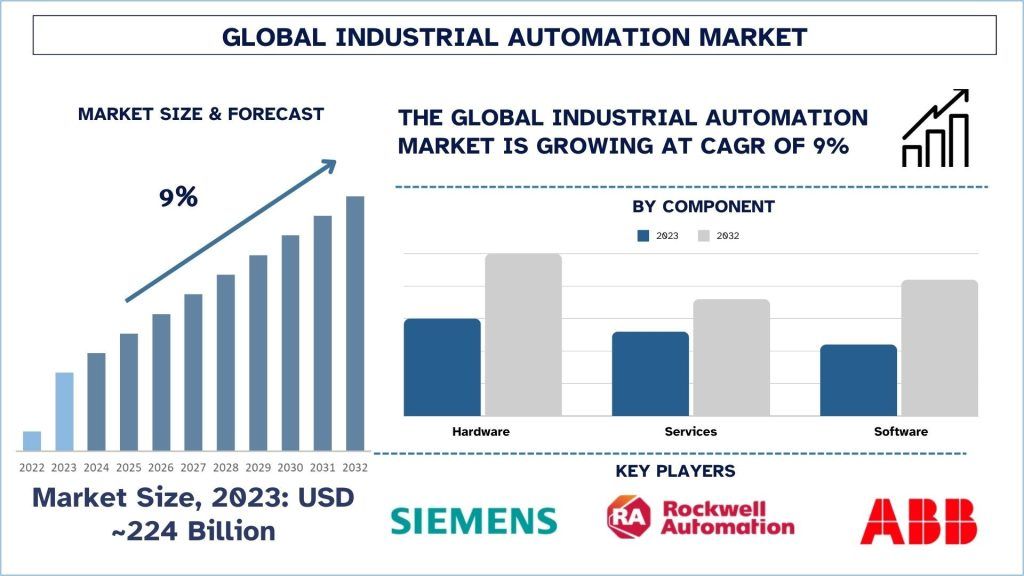
According to a new report by UnivDatos, the Industrial Automation Market is expected to reach USD Billion in 2032 by growing at a CAGR of 9% by increasing the efficiency of the processes, cutting costs, and increasing effectiveness in business operations. It helps companies to satisfy customer needs for increased product differentiation, delivery time, and quality as well as reduce energy consumption. Moreover, the increase in the application of new technologies, including the automation of work by Artificial Intelligence in organizational activities, will continue to dictate change in the redesign of business processes and structures. Furthermore, leading players have actively integrated mergers & acquisitions and joint ventures as important strategic moves to sustain the competition in the global market. In April 2024, Lear Corporation a global automotive technology leader in Seating and E-Systems, acquired WIP Industrial Automation (“WIP”). The acquisition builds upon Lear’s successful integration of ASI Automation, Thagora Technology SRL, and InTouch Automation as part of IDEA by Lear, the next phase of the company’s strategy to utilize technology and innovation to develop products and extend its leadership in operational excellence.
Access sample report (including graphs, charts, and figures): https://univdatos.com/reports/industrial-automation-market?popup=report-enquiry
Here are five examples of government regulations, laws, and legal frameworks that influence the Industrial Automation market:
Local/Regional Standards
· The countries of the world are working towards global harmonization of standards. This is especially evident in the area of machine safety. Global safety standards for machinery are governed by two organizations: ISO and IEC. Regional and country standards are still in existence and continue to support local requirements but in many countries, there has been a move toward using the international standards produced by ISO and IEC.
EN (European Norm) Standards
· For example, the EN (European Norm) standards are used throughout the EEA countries. All new EN standards are aligned with, and in most cases have identical text with ISO and IEC standards. IEC covers electrotechnical issues and ISO covers all other issues. Most industrialized countries are members of the IEC and ISO. Machinery safety standards are written by working groups comprised of experts from many of the world’s industrialized countries. In most countries, standards can be regarded as voluntary whereas regulations are legally mandatory. However, standards are usually used as the practical interpretation of the regulations. Therefore, the worlds of standards and regulations are closely interlinked.
· Industrial safety standards are typically structured into A, B, and C standards.
· Type A. Standards: Cover aspects applicable to all types of machines.
· Type B. Standards: Subdivided into 2 groups:
· Type B1 Standards: Cover particular safety and ergonomic aspects of machinery.
· Type B2 Standards: Cover safety components and protective devices.
· Type C. Standards: Cover specific types or groups of machines.
According to the report, the impact of industrial automation has been identified to be high for the North American area. Some of how this impact has been felt include:
Click here to view the Report Description & TOC: https://univdatos.com/reports/industrial-automation-market
North America is expected to grow with a considerable CAGR in the forecast period due to the advancement in technology and globalization of industries. Industry 4.0 with a mature manufacturing background is improving production efficiency relating to products and services in industrial markets. It is becoming apparent that organizations are using automation solutions to overcome the shortage of labor, increase the level of safety, and strengthen their position in the global market. For instance, on May 6, 2024, Comau is spearheading the Power of Automation with new digital-driven, advanced robotic, and powerful AI-backed automation solutions, unveiled at Automate, North America’s leading automation show. The region exhibits a robust inclination towards research activities that contribute to development, especially regarding automation solutions such as robotics and artificial intelligence.
Contact Us:
UnivDatos
Contact Number – +1 978 733 0253
Email – contact@univdatos.com
Website – www.univdatos.com
Linkedin- https://www.linkedin.com/company/univ-datos-market-insight/mycompany/


